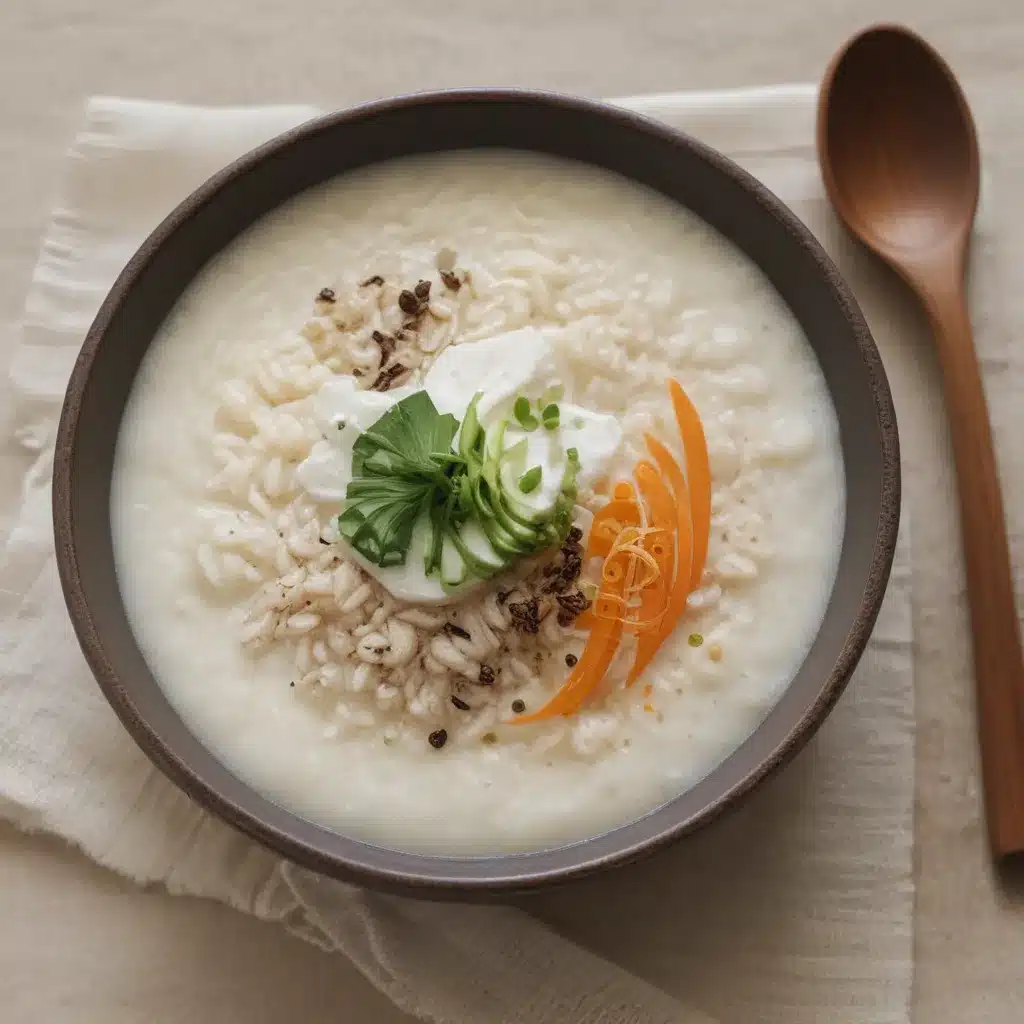
The Comfort of Congee
As I step into the bustling Korean restaurant in the heart of Boston’s Chinatown, the aroma of savory broth and simmering grains beckons me to a table tucked in the corner. This is where I’ve come to indulge in a bowl of soulful simplicity – Korean rice porridge, or juk.
Growing up, my Korean grandmother would prepare this comforting dish every Sunday morning. The gentle bubbling of the pot on the stove, the soothing scent of ginger and garlic, and the sight of her carefully adding each ingredient – it’s a memory etched deep within me. Even now, the mere thought of juk transports me back to that warm kitchen, where I would eagerly await my turn to stir the pot and learn the secrets of this age-old recipe.
As I settle into my seat, the server arrives with a steaming bowl, its surface dotted with savory toppings. I inhale the aroma, a symphony of umami notes that instantly soothes my senses. With the first spoonful, I’m greeted by a velvety, subtly sweet porridge that envelops my palate, nourishing me from the inside out. This is more than just a dish – it’s a connection to my heritage, a reminder of the love and care that goes into every bite.
The Art of Slow Simmering
The beauty of juk lies in its simplicity and the patience required to craft it. Unlike the quick-cooking rice dishes I’m used to, this porridge demands a gentle, unhurried approach. The key is to allow the grains to slowly release their starch, transforming into a silky, porridge-like consistency.
[1] According to the blog “Naturally Ella”, the high level of amylopectin in the rice grains is what gives juk its distinctive creamy texture. Unlike other grains that can become gummy when cooked this way, the unique properties of rice allow it to maintain a smooth, velvety mouthfeel [1]. It’s a delicate balance that requires the cook’s full attention and a willingness to let time work its magic.
As I watch the chef carefully monitor the pot, gently stirring and adjusting the heat, I’m reminded of the importance of slowing down in our fast-paced lives. In a world that often demands instant gratification, the art of juk preparation is a beautiful lesson in the virtue of patience and mindfulness. Each spoonful is a testament to the care and dedication poured into its creation.
Customizing the Comfort
While the foundation of juk is the slow-cooked rice, the true magic lies in the toppings and accompaniments that transform this humble dish into a symphony of flavors and textures. [2] As I peruse the menu, I’m delighted by the array of options, each one promising to elevate the porridge in its own unique way [2].
Do I opt for the classic Kongbap Juk, where the porridge is studded with earthy mung beans and garnished with crispy anchovies and pickled radish? Or perhaps the Tteokbokki Juk, where chewy rice cakes and spicy gochujang sauce lend a delightful contrast to the creamy base? The possibilities are endless, and each choice promises to transport me to a different corner of Korean culinary tradition.
As I ponder my decision, I’m struck by the versatility of juk. It’s a canvas upon which the chef can paint a vibrant tapestry of flavors, textures, and regional influences. [3] Whether it’s the robust, umami-laden toppings of the north or the delicate, fragrant accents of the south, every bite is a journey through the rich culinary heritage of the Korean peninsula [3].
A Nourishing Tradition
But juk is more than just a delicious meal – it’s a nourishing tradition that has sustained generations of Koreans. [4] According to the blog “Soup Chick”, the dish’s origins can be traced back to ancient times, when it was revered for its healing properties and ability to restore balance to the body [4]. Even today, Koreans turn to juk during times of illness or convalescence, understanding the restorative power of its simple, wholesome ingredients.
As I savor each spoonful, I can’t help but feel a sense of gratitude for the wisdom of my ancestors. In a world that often favors speed and efficiency over mindful nourishment, juk stands as a testament to the enduring value of slow, intentional cooking. It’s a reminder that true healing and comfort can be found in the most unassuming of dishes, as long as they are crafted with care and a deep respect for tradition.
The Warmth of Connection
But juk is more than just a dish – it’s a shared experience that connects Koreans, both at home and in the diaspora. [5] As I scroll through my Instagram feed, I’m delighted to see posts from Korean friends and food bloggers, each one showcasing their own unique take on this beloved porridge [5]. From the vibrant, kimchi-topped version of a Seoul-based chef to the comforting, mushroom-infused rendition of a homesick expat, these images remind me that juk is more than just a meal – it’s a cultural touchstone that transcends borders and brings people together.
As I set down my spoon, I feel a sense of contentment wash over me. In this bustling city, far from the familiar comforts of my grandmother’s kitchen, I’ve found a piece of home in this unassuming bowl of juk. It’s a reminder that the nourishment we seek, both physical and emotional, can often be found in the simplest of things – a warm, slow-cooked meal shared with loved ones, a connection to our roots, and the courage to slow down and savor the moment.
References:
[1] Knowledge from https://naturallyella.com/banana-pecan-amaranth-porridge/
[2] Knowledge from https://wongeats.com/tag/malaysian-food/
[3] Knowledge from https://www.soulfulandhealthy.com/recipes/dalgona-coffee-0
[4] Knowledge from https://www.instagram.com/craiglaban/?hl=en
[5] Knowledge from https://katlieu.substack.com/p/how-to-make-moms-comforting-congee
